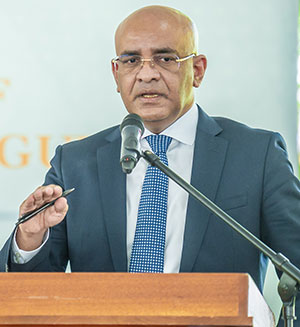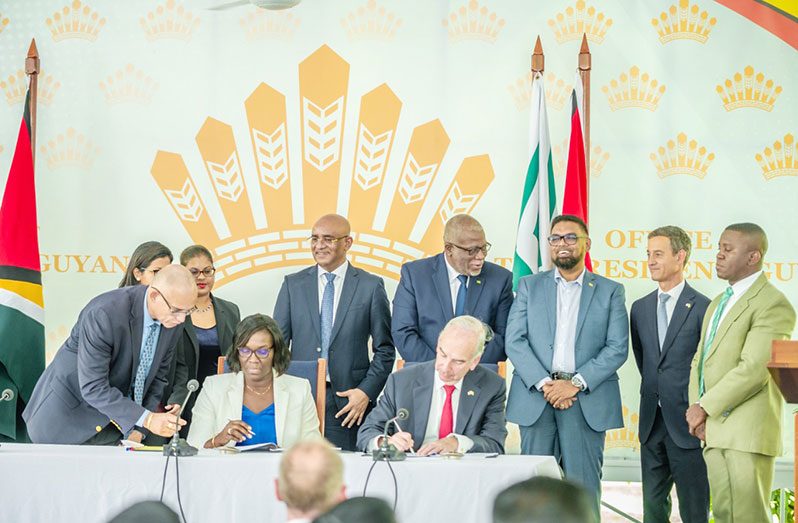–Hess signs agreement to pay nation a minimum of US$750M for carbon credits
–VP Jagdeo says country could earn more based on market changes
HESS Corporation on Friday signed an agreement with Guyana to pay a minimum of US$750 million to purchase 30 per cent of the country’s high-quality, REDD+ jurisdictional carbon credits.
The purchase of carbon credits is an important part of Hess Corporation’s commitment to support global efforts to address climate change and for the oil giant to achieve net zero greenhouse gas emissions by 2050.

Guyana has more than 18 million hectares of forests, storing an estimated 20 billion tonnes of carbon dioxide equivalent.
Cognisant of the benefits of forest resources, Guyana and other developing countries have called for compensation for their role in protecting the earth from greenhouse gases emitted mainly by large, industrial countries.
The Architecture for REDD+ Transactions (ART) had issued the world’s first The REDD+ Environmental Excellence Standard (TREES) credits to Guyana, marking the first time a country has been issued carbon credits specifically designed for the voluntary and compliant carbon markets for successfully preventing forest loss and degradation – a process known as jurisdictional REDD+.

“Following completion of an independent validation and verification process and approval by the ART Board of Directors, ART has issued 33.47 million TREES credits to Guyana for the five-year period from 2016 to 2020,” ART said in a press release.
Guyana on Friday secured its first sale of carbon credits, marking the culmination of a far-reaching vision, which was initially outlined in 2007 by then President, now Vice-President, Dr. Bharrat Jagdeo, who lobbied for financing for climate services. His vision led to the creation of the first Low Carbon Development Strategy.
The signing of the milestone agreement between Hess and Guyana for carbon credits, took place at State House, where President, Dr Irfaan Ali was joined by Vice-President Jagdeo and Chief Executive Officer (CEO) of Hess Corporation, John Hess.

Hess signed on behalf of his corporation, while Permanent Secretary of the Office of the President, Abena Moore, signed on behalf of Guyana.
“Today’s announcement is not only bold and innovative, but is also part of Guyana demonstrating leadership on a very critical and important issue. Developing counties have the capacity to present solutions to global problems,” Dr Ali said at the signing ceremony.
He added: “This is a very historic day for Guyana, for Hess and more important for forested countries. The importance of the forest and their significance in the fight against climate change has consistently been championed by Guyana and our Vice-President, Dr Bharrat Jagdeo.”
GREAT RESPONSIBILITY
The President commended Hess for exercising great responsibility in being part of the solution for climate change, through climate financing that ensures the preservation of forests.
Hess referred to the contract as a landmark agreement, crediting it to the hard work of the Vice President and President.
“Guyana is one of the most heavily forested countries in the world. We admire the efforts that Guyana has undertaken for years to protect the country’s forest, and the government’s constant efforts to combat climate change and provide a strong model for other countries, other businesses and other governments. We are pleased to support the country’s effort,” Hess said.
The historic multi-year agreement is for 37.5 million REDD+ jurisdictional carbon credits, current and future issuances. ART issued 33.47 million TREES credits to Guyana for the five-year period from 2016 to 2020. Hess is purchasing 30 per cent of this.
Guyana is the first to complete the ART process for generating high-integrity, Paris Agreement-aligned carbon credits that will allow the country to access market-based finance to continue to implement forest-stewardship strategies.
“The fact [is] that Guyana became the first country to be certified under ART TREE climate change framework. This has not happened by accident, it took hard work, long hours and strong commitment. Our commitment to climate change and protecting the forest is the main tool to work against climate change,” the President said.
The serialised credits, listed on ART’s public registry, are available to buyers on the global carbon market, including for use by airlines for compliance with the International Civil Aviation Organization’s global emission-reduction programme, CORSIA, as well as for use toward voluntary corporate climate commitments.
THE LEAST AMOUNT
While the least amount Guyana anticipates receiving from Hess is the US$750 million, the country could see itself receiving more money if the price of carbon credits rises on the global market.
“Just to put things in perspective, we’re selling 30 per cent of the credits available to Guyana over the period 2016 to 2030 for a minimum of $750 million; that’s a floor.
“Why do we say minimum? Because based on parameters established in the agreement, should there be movement in prices, we will share 60 per cent of the upside in movement of those prices. So, we anticipate the market to grow, the value of credit to grow in the future years and the agreement that we’re signing with Hess would allow us to share those upside benefits,” Vice-President Jagdeo said.
He added: “There is a deep sense of satisfaction to see how far we have come as a country, from the early days when a lot of discussions took place about the role of forests as a potential [climate change] mitigation.”
Research has shown that deforestation of tropical forests accounts for approximately 20 per cent of global annual greenhouse gas emissions. Understanding this, for years, Dr Jagdeo had campaigned for emphasis to be placed on tackling the emission that came from deforestation with the same global attention being given to mitigation efforts against other sources of emissions, and for it to be followed up with adequate financial mechanisms to ensure that it is viable.
“We pointed out that only [a] jurisdictional scale model could deliver lasting benefits, while the world were enamoured with project-based solutions. We said these forests have a value and that value must be recognised by the rest of the world. We came up with a figure and we said this figure is what it will take to outcompete alternative use of the forest,” Dr. Jagdeo said.
Guyana first tested this model when it inked an agreement with Norway in 2009 for a forest-protection deal between the two countries.
“It has been a long walk coming over 15 years; this is why we are so pleased today, we are evolving closer to the compliance market,” Dr Jagdeo noted.
Guyana’s completion of the ART process paves the way for other governments, which are looking to receive carbon-market financing for success in protecting and restoring its forests. Currently, 14 other countries and large sub-national jurisdictions are working towards their own issuances of TREES credits.



.jpg)








